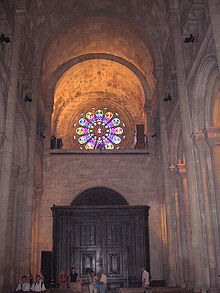
Back عقادة Arabic Цыліндрычнае скляпенне Byelorussian Цыліндрычнае скляпеньне BE-X-OLD Volta de canó Catalan Valená klenba Czech Tonnengewölbe German Barelvolbo Esperanto Bóveda de cañón Spanish Silindervõlv Estonian Kanoi ganga Basque



A barrel vault, also known as a tunnel vault, wagon vault or wagonhead vault, is an architectural element formed by the extrusion of a single curve (or pair of curves, in the case of a pointed barrel vault) along a given distance. The curves are typically circular in shape, lending a semi-cylindrical appearance to the total design. The barrel vault is the simplest form of a vault: effectively a series of arches placed side by side (i.e., one after another). It is a form of barrel roof.
As with all arch-based constructions, there is an outward thrust generated against the walls underneath a barrel vault. There are several mechanisms for absorbing this thrust. One is to make the walls exceedingly thick and strong – this is a primitive and sometimes unacceptable method. A more elegant method is to build two or more vaults parallel to each other; the forces of their outward thrusts will thus negate each other. This method was most often used in construction of churches, where several vaulted naves ran parallel down the length of the building. However, the outer walls of the outermost vault would still have to be quite strong or reinforced by buttressing. The third and most elegant mechanism to resist the lateral thrust was to create an intersection of two barrel vaults at right angles, thus forming a groin vault.
Barrel vaults are known from the Ancient Iran (Elam), Indian Indus Valley civilization and Ancient Egypt, and were used extensively in Roman architecture. They were also used to replace the Cloaca Maxima with a system of underground sewers. Other early barrel vault designs occur in northern Europe, Turkey, Morocco, and other regions. In medieval Europe, the barrel vault was an important element of stone construction in monasteries, castles, tower houses and other structures. This form of design is observed in cellars, crypts, long hallways, cloisters and even great halls.
© MMXXIII Rich X Search. We shall prevail. All rights reserved. Rich X Search